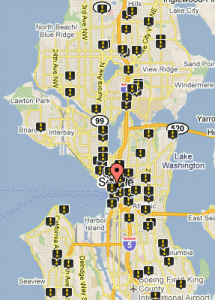A driver struck a pedestrian on Yesler a few days ago. The pedestrian did not have life-threatening injuries. However, the more interesting part of this is the many general comments on pedestrians rights at Central District News. A few excerpts below.
From gds:
I hope that the City takes this as an opportunity to do something about the cars that fly down Yesler in total disregard of the pedestrians trying to cross the street. I’ve almost been hit a few times, and seen it happen to others. While the crosswalk at 20th helps, I think we need a better solution.
From David:
I’m a responsible driver and I follow the rules. I’d like to think I’m doing my part to keep the road safe. For sake of argument, please allow me to place you in the shoes of the type of pedestrian against which I raise my complaint.
How are you treating me by imposing your will on me as a driver when you disregard the rules? How are you treating me when you willfully create a stressful and terrifying situation by jumping out in front of my car? I’d argue, you’re not treating me very well at all, all for the sake of saving yourself 30-60 seconds.
From LizWas:
people walking against a light at an intersection are still jaywalking and being irresponsible and unsafe. it’s so irritating! on the flip side, i work downtown and see cars running red lights daily. i have almost been hit numerous times. thankfully a more watchful pedestrian has pulled me back or called to get my attention when someone was running a red light. ridiculous. they’re (literally) going to kill someone.
I think all the east/west roads Union, Yesler, Jackson, specifically have become increasing dangerous. It’s the drivers and sure, sometimes it’s the pedestrians, aren’t paying attention .. and people drive very, very fast and many don’t stop for pedestrians in crosswalks and also at corners. It is a huge problem for those of us who walk as well as those of us who drive as it forces pedestrians to foist themselves out into traffic. The city needs to address this in an aggressive way.
From Dennis:
I walk my dog every morning when people are going to work. I cross Jackson and Yesler at 30th and 29th. It is very rare for cars to stop for me when I am clearly waiting to cross at the intersection.
I have mixed feelings about this. If it’s pouring and cold, it can mke me a bit crabby. But if a line of cars going uphill stop for me, they all burn extra gas as they resume movement. My dog and I, standing on the corner, do not have much of a carbon footprint! So what’s better?
From mommywhowalksAND drives:
The law is pretty simple for the driver… stop for pedestrians…. in MARKED & UNMARKED crosswalks. Not if you feel like. Or if you are not in a hurry. STOP. For pedestrians in crosswalks.
My sister & her husband in Beaverton OR BOTH got ticketed in a “failure to stop for pedestrians in crosswalks STING” and gladly took the tickets and the lesson.
Seattle PD could seriously raise awareness with periodic emphasis patrols and ticketing @ most dangerous intersections.
Comment from C:
I drive from MLK and Yesler to 6th and Yesler twice a day most days, and 4 times a day on Thursdays and Fridays. I have done this for 15 years. I echo what David said so well, “I’ve been exposed to a Seattle culture that seems assume that if you’re on foot or on a bicycle, heaven forbid if a law or ordinance should ever apply to you. I don’t think it contributes well to mutual safety for any of us.” If someone is standing at a corner waiting to cross, I stop, no matter what. This is because my brother was hit crossing the street 20 years ago, suffered a brain injury, and made me acutely aware of how breakable the human body is. I’m careful. I don’t want to hit anyone with my car. But the jaywalkers and bikers give me heart palpitations. FREQUENTLY as I near the library, jaywalkers – mostly young people. As I pass the old folks’ home, jaywalkers – mostly ladies in ethnic garb jaywalking after seeing their kids off on the bus. When I get to projects, jaywalkers – mostly elderly ladies (one who was hit by a car recently), and kids. At the Yesler overpass, jaywalkers galore – many of them employees from Harborview parking on the overpass then jaywalking across it. And all the way down Yesler there are bicyclists don’t obey traffic laws at all! They’re on the wrong side of the road, at night, wearing all black, or going against the light, weaving in and out. It’s like a human obstacle course. I agree with David that there is a bizarre culture of “I’m not in a car, I dare you to run me over.” It’s insane.
More here.




